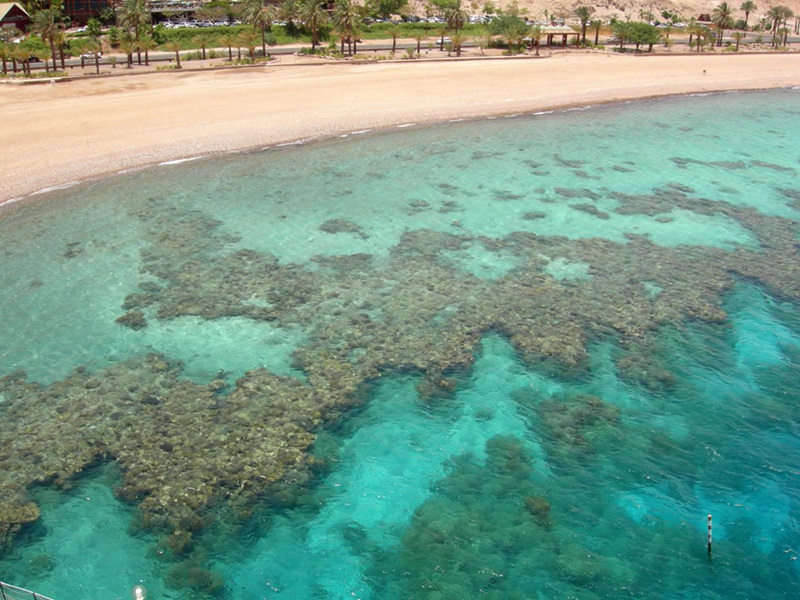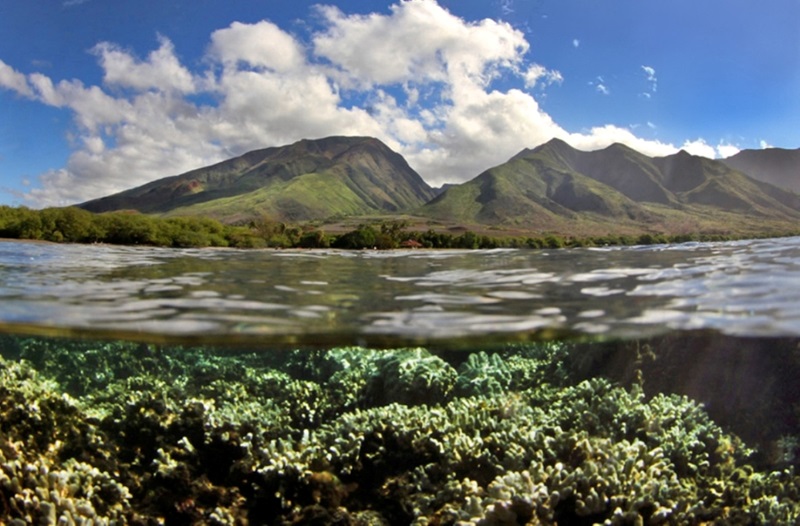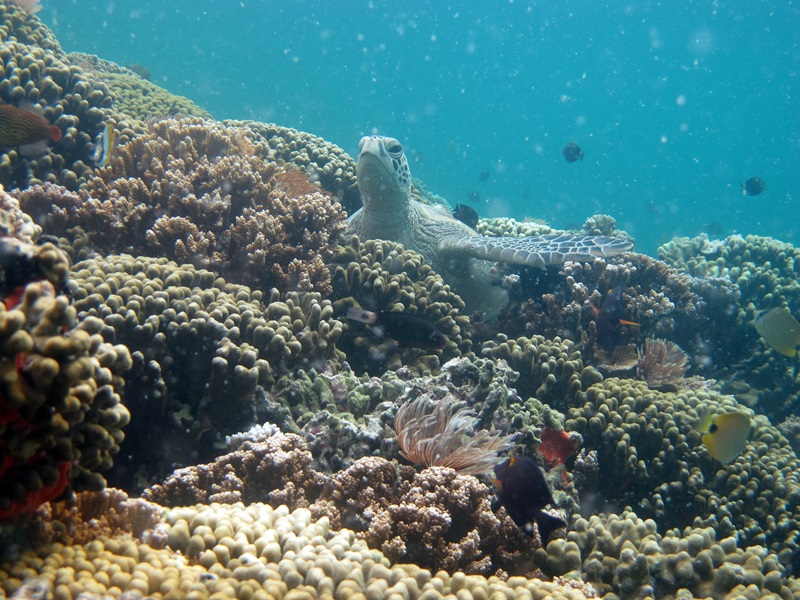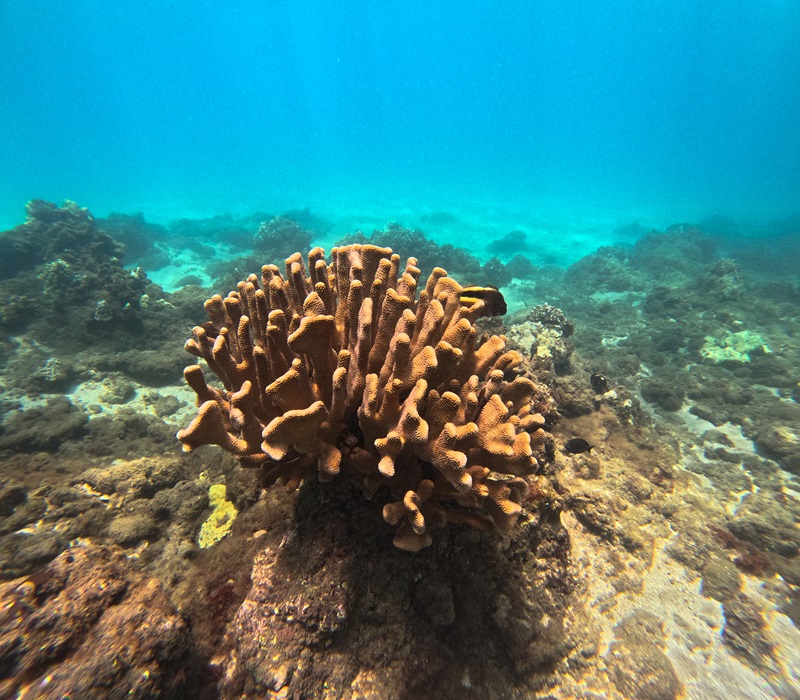Maui’s coral reefs are a vibrant underwater world with a variety of life. Nestled in the heart of the Pacific, these delicate ecosystems are a haven for snorkelers and divers alike. Explore the rainbow of colors and diverse marine life that call Maui’s coral reefs home. This guide will introduce you to the different types of reefs found around the island, the best snorkeling spots, and the ongoing efforts to conserve these precious resources.
Maui is a snorkeler’s paradise, boasting vibrant coral reefs. Coral reefs are important ecosystems that provide habitat for many marine creatures. There are three main types of coral reefs found around Maui: fringing reefs, barrier reefs, and patch reefs.
1. Fringing Reefs
Photo Courtesy of Wikipedia
Fringing reefs, as the name implies, fringe the coastline, growing directly from the shore. These reefs are a snorkeler’s delight, often just a short swim from the beach. Their proximity to land means they’re generally shielded from the full force of the open ocean, offering calmer waters and a safer environment for exploration.
This makes fringing reefs ideal for beginners and families with children. In Maui, these reefs teem with life, from colorful fish darting among the corals to sea turtles gracefully gliding through the water. The shallow waters and abundant sunlight filtering through the surface create a vibrant spectacle, perfect for underwater photography and observation.
2. Barrier Reefs
Photo Courtesy of Mission Blue
Barrier reefs are less common than fringing reefs. They stand as majestic guardians, further offshore from the mainland. A tranquil lagoon separates these reefs from the shore, creating a unique environment. Unlike fringing reefs, barrier reefs face the full brunt of the open ocean, resulting in more dynamic wave action and currents. These conditions, while challenging, foster a diverse ecosystem with specialized coral species adapted to the turbulent waters.
The lagoon itself is a sanctuary for juvenile fish and other marine life, providing a nursery for the next generation. Snorkeling on a barrier reef offers a different experience than a fringing reef, with deeper waters and the potential to encounter larger pelagic species. However, it’s important to be mindful of the stronger currents and choose a calm day for exploration.
3. Patch Reefs
Photo Courtesy of Scripps Institution of Oceanography
Patch reefs, as their name suggests, are scattered across the ocean floor like islands in a miniature archipelago. They are smaller, isolated formations that occur independently of larger reef systems, often found in shallow lagoons or on the sandy seafloor. While they may lack the grandeur of barrier reefs or the accessibility of fringing reefs, patch reefs harbor a unique charm and ecological significance.
These vibrant patches of life serve as essential stepping stones for marine creatures, offering food and shelter in otherwise barren stretches. Their isolation fosters a distinct biodiversity, with species adapted to the specific conditions of each patch. Snorkeling over a patch reef is like discovering a hidden treasure, revealing unexpected encounters and a glimpse into the intricate web of life that thrives beneath the waves.
Two Snorkeling Spots Perfect for Seeing Maui’s Coral Reefs
Molokini Crater and Coral Gardens are underwater wonderlands, captivating snorkelers and divers with their kaleidoscope of vibrant marine life.
Molokini Crater
Molokini Crater, a submerged volcanic caldera off Maui’s southern coast, is a testament to the raw power of nature. This crescent-shaped wonder, formed over 200,000 years ago, rises dramatically from the ocean floor, its rim barely peeking above the surface. This unique geological formation creates a haven for marine life, attracting an abundance of fish, coral, and other fascinating creatures. The crater’s sheltered interior acts as a natural aquarium, offering crystal-clear waters and unparalleled visibility for snorkelers and divers alike.
Descending into Molokini’s depths is like stepping into a kaleidoscope of vibrant colors and life. Schools of colorful fish, such as yellow tang, parrotfish, and Moorish idols, weave through the coral heads, while graceful manta rays occasionally glide through the open waters. The protected nature of Molokini ensures a thriving ecosystem, making it a prime spot for observing the intricate relationships between various marine species.
Snorkelers and divers can explore the crater’s inner walls, where the reef drops off into a deep abyss, or drift along the outer edges, where larger pelagic fish often congregate. Whether you’re a seasoned underwater explorer or a novice snorkeler, Molokini Crater promises an unforgettable encounter with the wonders of the ocean.
Check out tours to Molokini Crater here!
Coral Gardens
Coral Gardens, a vibrant underwater oasis on Maui’s western shores, is a snorkeler’s dream come true. Tucked beneath the majestic Pali cliffs, this underwater sanctuary boasts a kaleidoscope of colors, thanks to its flourishing coral formations. Some of these corals are among the oldest in Hawaii, having silently witnessed centuries of marine life unfold before them.
Unlike some of the island’s more remote snorkeling spots, Coral Gardens is easily accessible by boat, making it an ideal destination for snorkelers of all levels, from beginners to seasoned pros. The calm, clear waters provide excellent visibility, allowing you to fully immerse yourself in the underwater spectacle. As you glide through the water, you’ll be greeted by an abundance of marine life, from playful butterflyfish to majestic sea turtles, all amidst the backdrop of this ancient coral wonderland.
Protecting Maui’s Coral Reefs
Snorkelers should be respectful of coral reefs. Don’t touch or step on the coral, and use reef-safe sunscreen.
Marine Protected Areas (MPAs) are one way to protect coral reefs. MPAs limit human activities that can harm the reef, such as fishing and pollution. Sustainable tourism practices are another way to protect coral reefs. This includes educating visitors on how to snorkel and dive responsibly.
Research and monitoring are important for understanding the health of coral reefs. This data helps scientists develop conservation strategies. Community involvement is also important for coral reef conservation. Local communities can help remove debris and invasive species from the reef.
Climate change is a major threat to coral reefs. Coral reefs are dying because of ocean warming and acidification. Efforts to reduce greenhouse gas emissions can help mitigate climate change. Restoration projects are also becoming increasingly important for coral reefs. These projects involve growing coral in nurseries and transplanting them to damaged areas.
Protecting Maui’s coral reefs requires a multifaceted approach. This approach includes government regulations, community action, scientific research, and individual responsibility. By working together, we can preserve these ecosystems for future generations.
In Conclusion
Maui’s coral reefs are a testament to the delicate balance of nature and a treasure trove of biodiversity. From the vibrant shallows of fringing reefs to the majestic depths of Molokini Crater, each reef offers a unique glimpse into the underwater world. As we snorkel or dive among these underwater wonders, we are reminded of the importance of conservation and responsible tourism. Let us all do our part to protect these fragile ecosystems, ensuring that future generations can also marvel at the beauty and wonder of Maui’s coral reefs.







